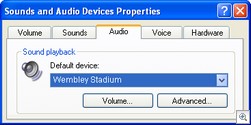3 Jan, 2008
 There once was a time that we had to use a PC speaker to hear sound effects in games. Some games even offered small digitised voice effects, which we were impressed with at the time. The next stage was adlib soundcards which could handle midi sounds. They were still fairly weak, but they were a huge improvement on what we were once used to.
There once was a time that we had to use a PC speaker to hear sound effects in games. Some games even offered small digitised voice effects, which we were impressed with at the time. The next stage was adlib soundcards which could handle midi sounds. They were still fairly weak, but they were a huge improvement on what we were once used to.
Since that time, soundcards have evolved into a very important feature in any computer. The sound quality which comes out of even the cheapest cards is good enough to listen to music or to watch a movie. Why not take full advantage of this technology and hook it up to your sound system to get your MP3’s pumping.
Current PC speakers on the market sound quite good, but they will never be able to recreate the awesome sound you can get out of your main sound system. It shouldn’t cost you more than a few dollars to setup. Even if you don’t want to set this up for permanent use, it is worth keeping in mind for parties as it will be appreciated by your guests. I haven’t bothered with PC speakers for years as it is easier for me to connect my computer to my sound system.
This article will show you how to connect your computers soundcard to your sound system. I have already written an article explaining “How-to: Connect your PC to your television and stereo”, but I placed a large emphasis on the video side of things and many of the comments are related to audio. This article will only cover audio. I hope you will be amazed how easy it is.
Read the rest of this entry »
19 Dec, 2007
Difficulty Rating:

Have you ever noticed that when you get started on a particular task on your computer, you always open up the same bundle of programs to do it? Why not make it easier for yourself and get all of these programs loading up when you want them, with a single click. The answer is batch files.
Batch files have been around longer than Windows has, but sadly they have been forgotten over the years. Generally, DOS is not a nice environment to work in compared to the graphical operating systems we have these days. I feel batch files still have their place. They are very simple to create and they can be edited easily.
You may have already set up your computer to automatically launch particular programs as part of your computers start up sequence. While this will work, it is not really the ideal situation, because you may not be ready to use the programs straight away. This can slightly slow you down or clutter your workspace, for no good reason. Instead, if you use batch files, your specified programs will launch simultaneously with one click, only when you’re ready to use them.
In this article we will look at how to create some basic batch files which you can alter to suit your own needs. For this How-to article, I am going to use batch files to launch environments, e.g. turning your computer into a multimedia heaven.
Read the rest of this entry »
3 Dec, 2007
 Often the first piece of hardware to cause us grief on a computer is the internal case fan. These fans can give off a really nasty grinding sound after a couple of years, normally due to dust buildup in the inner workings of the fan. Rather then replacing the fan, we can initially try to dislodge the dust.
Often the first piece of hardware to cause us grief on a computer is the internal case fan. These fans can give off a really nasty grinding sound after a couple of years, normally due to dust buildup in the inner workings of the fan. Rather then replacing the fan, we can initially try to dislodge the dust.
Dust is less likely to effect the CPU and video card fans because these fans are usually of higher quality and they don’t have the same access to external dust. I would not try this method for these fans as it is likely to do more harm than good.
As a precaution, it is sensible to either remove the fan from the case or to remove the hard drives from the computer. We don’t want any vibrations resulting in this method to cause your hard drive grief. I say this as a disclaimer, but I have never had any problems bypassing this step.
Find yourself a screwdriver, pull the cover off your case and turn on your computer. Hold your PC case steady and strike the sticker on the fan with the butt of the screwdriver. Start with very gentle strikes and work your way up. You should not need to strike very hard to clear out the dust.
I have used this method on numerous occasions and had great success. The worst case is that you break the fan, that you were likely going to replace in any case. If you can be bothered, now would be a good time to vacuum the inside of the machine whilst the cover is off.
It’s primitive, but it works a dream.
27 Nov, 2007
Difficulty Rating:
 Spam plagues our Inbox each day. Emails advertising Rolex watches, penis enlargements, viagra and emails from Nigeria offering me vast amounts of money for doing nothing, are all very annoying, but we are able to get rid of most of them automatically.
Spam plagues our Inbox each day. Emails advertising Rolex watches, penis enlargements, viagra and emails from Nigeria offering me vast amounts of money for doing nothing, are all very annoying, but we are able to get rid of most of them automatically.
Email servers often have spam protection built in. These cull the majority of spam, but they have to allow a fair chunk of spam through so as to not restrict legitimate emails. Sometimes if they are unsure, they may add a spam tag to the subject. It is scary looking at server stats, just how much is stopped at the server level.
In our email client we are able to setup rules to remove the majority of remaining spam from our Inbox. I regularly find myself doing this on computers where I work and have found this method to be very reliable.
This article will show you how to setup basic email rules which will check mail as it is received. The rules will look for keywords in the body and the subject of you emails to decide if they are spam or not. We are then able to move these filtered emails to a folder of our choice.
Read the rest of this entry »
26 Nov, 2007
Difficulty Rating:
 Shortcuts are a very important feature of any operating system. We use them to launch programs and our Internet Explorer favourites, or we can use them to make our computer perform set tasks.
Shortcuts are a very important feature of any operating system. We use them to launch programs and our Internet Explorer favourites, or we can use them to make our computer perform set tasks.
In my job, I find myself regularly being asked how to make shortcuts. I would normally first advise users to get rid of the unnecessary links to readme files and uninstallers so that their utilities stand out more.
Saying that, shortcuts are really easy to make and are sometimes necessary. As shortcuts are used in every operating system, I thought I would have a look into them a little further and try to get some creativity going so that we can get the most out of our shortcuts.
Over the past week there have been a number of great posts around the blogosphere about how to make shortcuts to do certain tasks. These inspired me to write an article that would allow you to get your shortcuts to work for you more effectively.
In this article, we will create shortcuts to a handful of little utilities, existing Windows utilities and Windows features. The end result will be an easily accessible group of shortcuts that can be launched quickly and without hesitation.
By the time you have finished reading this article, you should have a workforce of shortcuts ready to be used with a single click. You have one location to access them all. It is sort of like having your own customised control panel on hand.
Read the rest of this entry »
 There once was a time that we had to use a PC speaker to hear sound effects in games. Some games even offered small digitised voice effects, which we were impressed with at the time. The next stage was adlib soundcards which could handle midi sounds. They were still fairly weak, but they were a huge improvement on what we were once used to.
There once was a time that we had to use a PC speaker to hear sound effects in games. Some games even offered small digitised voice effects, which we were impressed with at the time. The next stage was adlib soundcards which could handle midi sounds. They were still fairly weak, but they were a huge improvement on what we were once used to.

 Often the first piece of hardware to cause us grief on a computer is the internal case fan. These fans can give off a really nasty grinding sound after a couple of years, normally due to dust buildup in the inner workings of the fan. Rather then replacing the fan, we can initially try to dislodge the dust.
Often the first piece of hardware to cause us grief on a computer is the internal case fan. These fans can give off a really nasty grinding sound after a couple of years, normally due to dust buildup in the inner workings of the fan. Rather then replacing the fan, we can initially try to dislodge the dust. 
 Shortcuts are a very important feature of any operating system. We use them to launch programs and our Internet Explorer favourites, or we can use them to make our computer perform set tasks.
Shortcuts are a very important feature of any operating system. We use them to launch programs and our Internet Explorer favourites, or we can use them to make our computer perform set tasks.